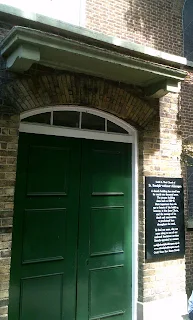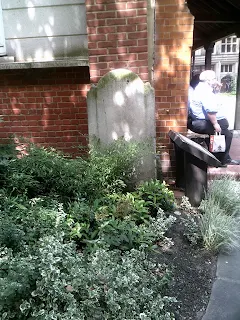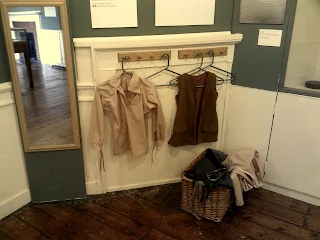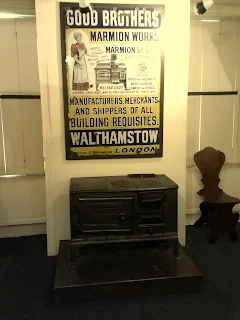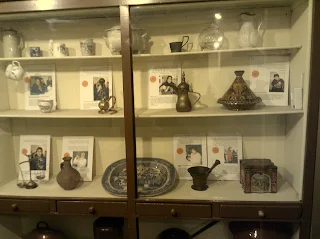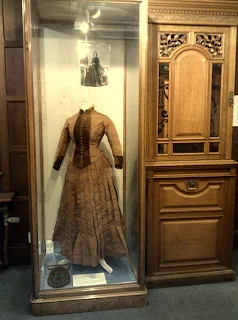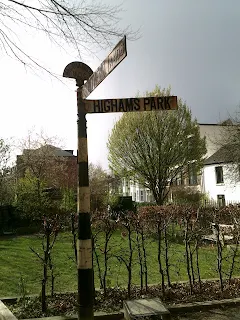I stumbled across the existence of Postman's Park- so called because of its popularity as a lunchtime garden with postal workers from the old General Post Office, which was in the vicinity- by accident on the Internet. The article mentioned that it's raised a few feet above street level due to its former occupation as the churchyards of: St Leonard, Foster Lane; St Botulph, Aldersgate and the graveyard of Christchurch, Newgate Street.
Of course, the mention of DEAD BODIES would arouse the interest of the macabre and gothic Miss Elaineous!
Here is a photo of the map at the entrance to the garden, explaining its history...
This map gives you some idea of the relationships the former graveyards bore to each other vicinity-wise. The park is bordered by a street named Little Britain, which of course made me think of the TV comedy programme and raised a smile.
Only St Botulph's Aldersgate remains as a working church. Unusually, because of its location in a commercial area with few local residents, services are held on a Tuesday, rather than the more traditional Sunday.
Here is the entrance the the church. It's a rather insignificant looking door...
Historically, there was a severe lack of burial spaces in London. This meant that graves would often be reused, and the difficulty of digging without disturbing existing graves led to bodies simply being stacked on top of each other and covered over with earth. Serious outbreaks of cholera in the early and mid 19th century had led to bodies being stacked in heaps as they awaited burial, and even for relatively new graves to be exhumed to make way for new burials. Gravediggers throughout London were required to shred bodies so that they could be crammed into any available resting space.
Public health at the time centred around the (now obsolete) 'miasma theory' which dictated that 'bad air' caused disease. By this time the differing number of parishioners in each parish meant that the ground level of St Botulph's churchyard was 6 feet above that of the Christchurch burial ground and 4 feet above that of St Leonard.
In the wake of public concern, the Burials Act of 1851 meant that the seven large cemeteries that had recently opened around London became the metropolis's main burial grounds. in 1858, it was decided to convert the churchyard of St Botulph into a park, with the Churchwardens announcing:-
The Churchwardens of the above parish hereby give notice that they intend to plant, pave, or cover over the churchyard and burial-ground. Persons having relatives interred in the said churchyard or burial-ground will be permitted (under certain regulations) to remove and inter the remains of such relatives in any burial-ground or cemetery, without the city. Persons also, to the memory of whose relatives any tomb, monument, or inscription may have been erected therein, may (under the like regulations) cause such tomb or grave-stones to be removed and taken away; but such removal, in either case, must be at the expense of the persons causing the same to be done. Applications for either of the above purposes must be made, in writing, on or before Monday, the 20th day of December, 1858. (Source:- Wikipedia).
The burial ground was cleared and levelled and the remaining gravestones stacked against the wall...
My discovery of the existence of this park coincided with me being in the area as I had Othello at Sheakespeare's Globe to attend, and I always use the convenient St Paul's Tube station and cross the river via the Millennium Bridge.
It was a scorching day when I popped into the park and also lunchtime, so I couldn't get too close to a lot of things as the park abounded with people.
As I walked in, I passed this Grade II listed drinking fountain at the entrance.
Just inside is this lovely, peaceful fountain...
Looking back towards my entrance point...
View straight through to the other side (of the park- I don't mean holding a seance and contacting the dead!)
The centre of the park...
I liked this section of garden but don't know what the memorial/ decorative plinth is for...
The description wasn't very legible on what I assume to be a tomb...
Ditto. I had this recorded in my notes as, 'a lump of something'!
The view out of the park and onto the City...
The Memorial to Heroic Self Sacrifice was the brainchild of George Frederic Watts, a painter and sculptor who was an advocate for the idea of art as a means of force for social change.
This memorial was all about commemorating ordinary people- who might otherwise be forgotten- who had died saving the lives of others.
I couldn't get too close to photograph it as people were in abundance on this lovely, sunny lunchtime...
Work commenced in 1899 and this is what the individual plaques look like. This one is dedicated to Alice Ayres, a maid who lost her young life saving the three children in her care.
This is a PDF as I wasn't able to sift amongst the people eating their lunch and photograph it myself.
Postman's Park featured in the 2004 film Closer as part of a key plot element. It is revealed that the character Alice Ayres (played by Natalie Portman) has fabricated her identity based on Ayres' tablet on the Memorial to Heroic Self Sacrifice. I think I will have to check the film, based on the 1997 play Closer, by Patrick Marber, out.
The plaques are on the side of St Botulph's, and are awards for the presentation of the gardens...
This old fashioned police call box was just outside the park. It's good that elements of history have been retained around the City...
I took this photo purely because I thought the Bull and Mouth Inn sounded like an interesting name for a pub. It's a shame it's not still there!
TTFN from The Miss Elaineous.
XXXXXXXXXXXXXXXXXXXXXXXXXXXXXXX


